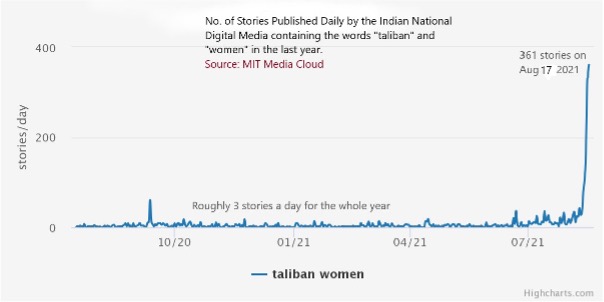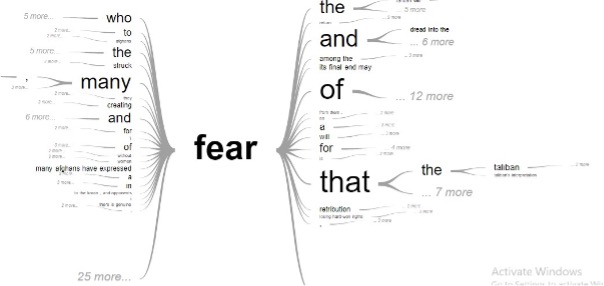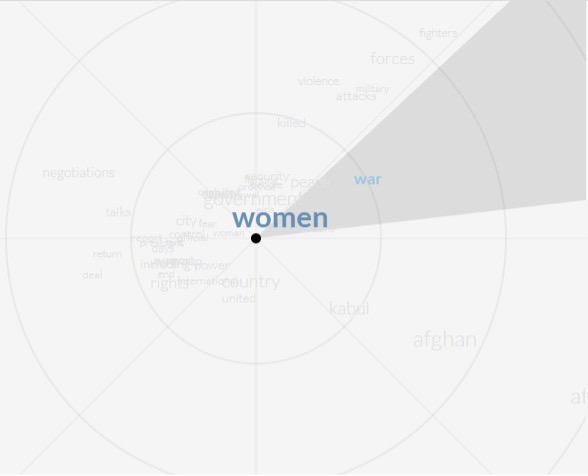
The Taliban Takeover and Women Rights: A Media Coverage Analysis
22-May-2025
By Saif Ali
The Taliban took over Afghanistan with a spectacular victory in Kabul on 15 August 2021, and the incumbent leader fled the country. The takeover was a shock that altered the region's geopolitics and gave rise to widespread speculation in the news media about the likely repercussions. This article briefly analyses news coverage patterns in the Indian digital news media shortly after the Taliban takeover. In particular, it looks at an acute concern that the national digital media in India seemed to develop for women's rights in Afghanistan suddenly. The number of stories about women published digitally rose 9000% within two days of the Taliban's ascent to power. While the national media published 3-4 stories per day on average in the preceding year on the subjects of "Taliban" and "women", the number of stories rose to a staggering 361 stories in one day (17 August 2021).

Figure 1: Stories published daily between July 2020 and August 2021 by 138 digital news media sources in the Indian national news ecosystem containing the words "Taliban" and "women"
No woman is in the top ten most mentioned people in these stories. The person mentioned most frequently is former president Ashraf Ghani (786 mentions), followed by then-US president Joe Biden (666 mentions). Malala Yousafzai is at number 15 (111 mentions), ahead of Narendra Modi at number 16. Afghan politician and women's rights activist Fawzia Koofi ranks 27th with only 59 mentions.
Among the top 5 organisations mentioned in the corpus of stories besides the Taliban, two are military establishments - NATO and the Pentagon. The United Nations ranks fourth, the only organisation directly related to women's rights. There are virtually no other women's rights organisations that feature prominently, space being given instead to military outfits like Al-Qaeda (110 mentions), ISIS (92 mentions) and political groups like the BJP (60), the Trump Administration (78) and intelligence agencies like the CIA (58). Human Rights Watch finds 31 mentions, ranking 58 in the list. There is a gaping void where one would expect strong representation from women and women's rights groups in a conversation centred on women’s rights.
Let us now turn to the voice and sentiment of news articles. The word "rights" is often preceded by the word "women's" (as expected) and followed by words like "advocates" and "activists", but again, the actual names of these activists do not appear to feature in the content of the stories. A similar lack of specificity surrounds the word "fear", which is most frequently preceded by the vague word "many" and followed by the words "that the Taliban.” The obscurity of women’s voices and the identity of those who fear the Taliban raises an obvious question about fear-mongering. Why would the news articles highlight that “many” fear the Taliban without mentioning who they are?

Figure 2: Usage and context of the word "fear" in news stories containing the words "Taliban" and "women"
MIT Media Cloud – the tool used to run this analysis – has a feature called "word space", which shows how words are used in a corpus. It visualises words most frequently used in similar contexts, where co-occurrences determine context. This is based on the “distributional hypothesis” in linguistics, which says that words used in similar contexts tend to carry similar meanings. In the word space for the corpus made of stories on Taliban and women, the word "women" was strongly associated with the word "war" and other words such as “government”, “control”, and “power.” This suggests that the Indian digital news media framed the issue of women’s rights in Afghanistan within the context of political and military power.

Figure 3: Word space for a news story corpus containing the words "Taliban" and "women" published between July 2020 and August 2021
The Taliban faces a considerable challenge in the new phase of its history. Merciful and just governance, in a way, is more difficult than fighting off world powers. Giving women their rightful place in society is a problem that virtually every country is grappling with, so the Taliban have their work cut out for them on this front. Given the kind of coverage we have seen from the world media and the self-reported stories from Afghan women, a genuine concern for the women of Afghanistan is well placed.
But several confounding factors compel us to explore alternative angles to this rising concern for women in the Indian media. Firstly, the timing of this impressive rise in media coverage around women's rights immediately after the siege of power in Kabul indicates that we cannot ignore the issue of power when interpreting the coverage trends. Second, why amplify the voices of male political leaders and privilege the mentions of military organisations over and above those of women and women’s rights groups? Shouldn’t Afghan women spearhead the conversation about women’s rights in Afghanistan? Third, why linguistically conflate women’s rights with war? No significant evidence was found in the present study that the conversation touched on more critical issues such as safety, representation, education, choice, consent, and freedom. We are compelled to ask if women’s rights are simply a pretext for the Western military intervention and control in Afghanistan and the Muslim world at large. While this news coverage analysis can not directly answer this question, it establishes the need to dig deeper into it.
Sources
MIT Media Cloud is an open-source, news analysis platform developed by researchers at the MIT Media Lab.
© 2025 The Nehru Centre. All Rights Reserved.
